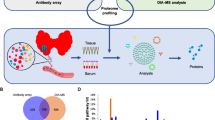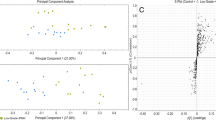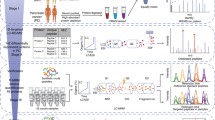Abstract
Background
Thyroid carcinoma is the most common endocrine malignancy and a common cancer among the malignancies of head and neck. Noninvasive and convenient biomarkers for diagnosis of papillary thyroid carcinoma (PTC) as early as possible remain an urgent need. The aim of this study was to discover and identify potential protein biomarkers for PTC specifically.
Methods
Two hundred and twenty four (224) serum samples with 108 PTC and 116 controls were randomly divided into a training set and a blind testing set. Serum proteomic profiles were analyzed using SELDI-TOF-MS. Candidate biomarkers were purified by HPLC, identified by LC-MS/MS and validated using ProteinChip immunoassays.
Results
A total of 3 peaks (m/z with 9190, 6631 and 8697 Da) were screened out by support vector machine (SVM) to construct the classification model with high discriminatory power in the training set. The sensitivity and specificity of the model were 95.15% and 93.97% respectively in the blind testing set. The candidate biomarker with m/z of 9190 Da was found to be up-regulated in PTC patients, and was identified as haptoglobin alpha-1 chain. Another two candidate biomarkers (6631, 8697 Da) were found down-regulated in PTC and identified as apolipoprotein C-I and apolipoprotein C-III, respectively. In addition, the level of haptoglobin alpha-1 chain (9190 Da) progressively increased with the clinical stage I, II, III and IV, and the expression of apolipoprotein C-I and apolipoprotein C-III (6631, 8697 Da) gradually decreased in higher stages.
Conclusion
We have identified a set of biomarkers that could discriminate PTC from non-cancer controls. An efficient strategy, including SELDI-TOF-MS analysis, HPLC purification, MALDI-TOF-MS trace and LC-MS/MS identification, has been proved successful.
Similar content being viewed by others
Background
Thyroid carcinoma is the most common endocrine malignancy and a common cancer among the malignancies of head and neck. It comprises 91.5% of all endocrine malignancies and 1% of all malignant diseases [1]. An estimated 33550 new cases are diagnosed annually in the United States and recent statistics shows the incidence of thyroid carcinoma has increased, especially in papillary thyroid carcinomas (PTC) [2]. PTC is the most common type, which accounts for 80% of all thyroid cancers [3]. Early accurate diagnosis and timely treatment are critical for improving long-term survival of PTC patients. Many diagnostic tools have been used for thyroid carcinoma, such as sonography, computed tomography, magnetic resonance imaging, cytological examination and fine-needle aspiration. Currently, although ultrasound-guided fine-needle aspiration biopsy is considered as the most effective test for distinguishing malignant from benign thyroid nodules, its sensitivity is approximately 93% and its specificity is 75% [4]. At the same time, researchers have been seeking valuable biomarkers for thyroid carcinoma diagnosis, such as galectin-3, fibronectin-1, CITED-1, HBME1, cytokeratin-19 and TPO, and so on. What is disappointing is that all these biomarkers either are lacking specificity to some degree, or have a poor positive predictive value [5–9]. To distinguish a malignant thyroid nodule from a benign lesion more accurately, the diagnostic test, however, still needs to be improved. Moreover, a noninvasive screening method for thyroid malignancy remains unavailable.
Recent advances in the proteomics study have introduced novel techniques for the screening of cancer biomarkers and improved early and accurate diagnosis of cancer diseases to a new horizon [10]. Surfaced enhanced laser desorption/ionization time of flight mass spectroscopy (SELDI-TOF-MS), which generates the protein fingerprint by MS, has been proved a powerful tool for potential biomarker discovery [11, Full size image
Protein peak validation
The remaining 48 PTC and 76 control serum samples (20 healthy controls and 56 patients with benign thyroid node) as a blind testing set, were analyzed to validate the accuracy and validity of the classification model derived from the training set. The descriptive statistics of the three markers in 48 PTC patients and 76 non-cancer controls are shown in Table 2. The classification model distinguished the PTC samples from controls with a sensitivity of 95.15%, specificity of 93.97%, and positive predictive value of 96.0%, respectively. The area under the receiver operating characteristics (ROC) curve of this model was 0.971.
Purification and identification of candidate protein biomarkers
Serum samples from PTC patients were used for the purification of the up-regulated candidate protein biomarker (9190 Da), and serum samples from healthy controls were used for the purification of the two down-regulate proteins (6631, 8697 Da) using WCX SPE and C18 HPLC. Figure 3 shows the results of MALDI-TOF-MS analysis of the three purified candidate protein biomarkers.
After digestion with modified trypsin, the peptide mixture was analyzed by nano-LC-MS/MS. Figure 4 shows the results of the LC-MS/MS chromatogram (A) and MS/MS spectrum of one identified peptide (B) from protein (8697 Da). Table 3 shows the results of identification of the three candidate protein biomarkers. They were haptoglobin alpha-1 chain (9190 Da) [NCBI:P00738], apolipoprotein C-I (6631 Da) [NCBI:P02654] and apolipoprotein C-III (8697 Da) [NCBI:CAA25233]. The whole sequence of the three candidate protein markers is given by combination of high sequence coverage and accurate molecular weight (MW) measurement using MALDI-TOF-MS.
Validation of three candidate protein biomarkers
A ProteinChip-array-based immunoassay (Ciphergen Biosystems) was used to specifically capture haptoglobin alpha-1 chain, apolipoprotein C-I and apolipoprotein C-III from crude serum samples and to confirm the significance of each marker. The anti-haptoglobin alpha-chain antibody specifically captured the previously identified 9190 Da protein. The anti-apolipoprotein C-I array was developed to capture apolipoprotein C-I (6631 Da) and the apolipoprotein C-III antibody against specifically captured apolipoprotein C-III (8697 Da). (Figure 5)
Representative spectra from ProteinChip array with specific immobilized antibodies. (A) Representative spectra of the negative control (nonspecific rabbit IgG). (B) Representative spectra from ProteinChip array with anti-haptoglobin alpha chain antibody. (C) Representative spectra from ProteinChip array with anti-apolipoprotein C-I. (D) Representative spectra from ProteinChip array with anti-apolipoprotein C-III.








